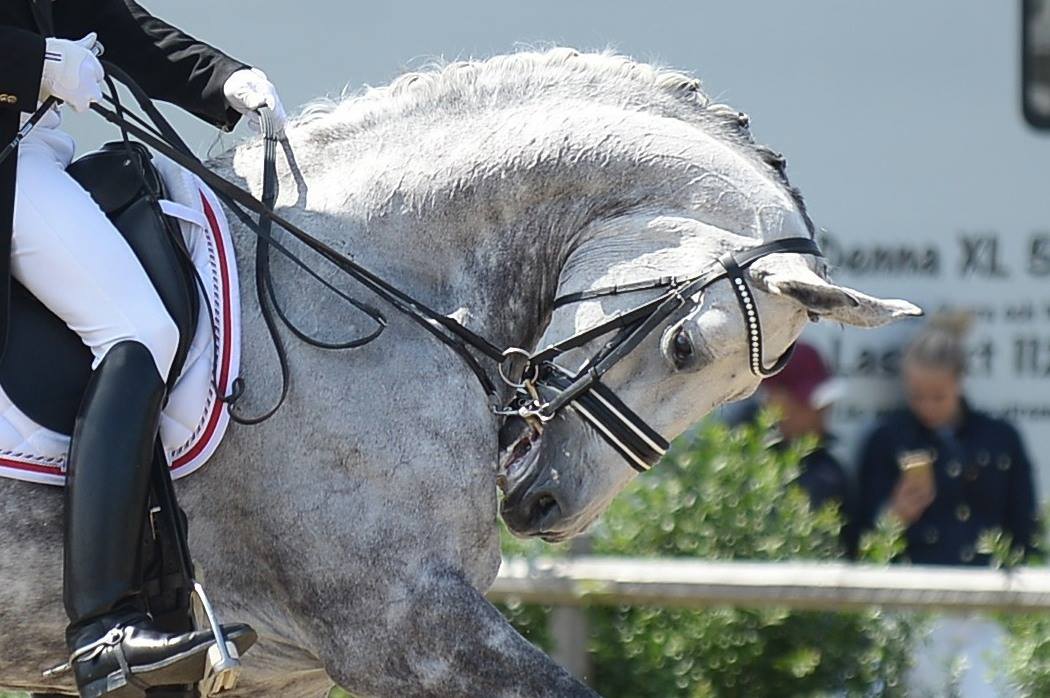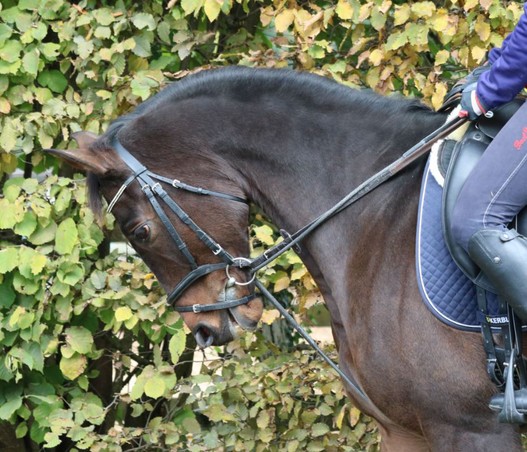Another Comment on the Proper Use of Tack
 I hadn’t really intended to continue in the vein of animal rights activism that I alluded to so very briefly in my last blog, but I came across the article below online and decided that it was worth translating and sharing with you all. It had only been published in German and French but I think the message is worth the effort. Again – I’d be interested in reading your comments on this. It ties in with the decision made almost 6 years ago by the FEI to establish guidelines limiting the use of rollkuer, but the debate continues as the responsibility for enforcement mostly rests with officials at dressage competitions. Until it becomes ‘law’ (such as what is now happening regarding the use of draw reins), interpretation is still somewhat subjective.
I hadn’t really intended to continue in the vein of animal rights activism that I alluded to so very briefly in my last blog, but I came across the article below online and decided that it was worth translating and sharing with you all. It had only been published in German and French but I think the message is worth the effort. Again – I’d be interested in reading your comments on this. It ties in with the decision made almost 6 years ago by the FEI to establish guidelines limiting the use of rollkuer, but the debate continues as the responsibility for enforcement mostly rests with officials at dressage competitions. Until it becomes ‘law’ (such as what is now happening regarding the use of draw reins), interpretation is still somewhat subjective.
Unfortunately the technique known as “LDR” (low, deep and round) is still recognized; where does one end and the other begin? LDR is supposed to be achieved ‘without force’ – but how is this level of flexion determined from the ground as being ‘forced’ (rollkuer/hyperflexion) or not (LDR)? Must the horse’s chin be nearly touching its chest for it to be a clear case?
Sometimes horses will even overflex on their own – but perhaps this is to avoid the pressure of the bit. There are professionals who argue that flexion improves the horse’s way of moving. The reality however, is that it can be extremely physically damaging – in ways that may not show up until years later. But even veterinary research cannot come to conclusive evidence. The questions that need to be answered (not only for rollkuer, but for other ‘accessories) are basically:
- Is rollkuer physically (and mentally damaging to horse)
- Are some riders more skilled than others and should therefore be allowed to use it
- What exactly is the difference between rollkuer and LDR
- What is an acceptable length of time for a horse to be ridden in the flexed position (forced or not – at present the limit is at 10 minutes)
The main thing is that issues like this are actually being discussed – and that is encouraging for the sport. So, now on to the draw reins ruling:
 NEWS: General Ban on draw reins for the health of the horse and the longevity and protection of the sport SWISS EQUESTRIAN FEDERATION BULLETIN
NEWS: General Ban on draw reins for the health of the horse and the longevity and protection of the sport SWISS EQUESTRIAN FEDERATION BULLETIN
Oct. 19, 2015
Equestrian sports are in the public eye and not always perceived very positively. Photos of horses in draw reins cause feelings of disquiet for the uneducated public, which equates these images with force and submission. The Swiss Equestrian Association continues to act proactively for the protection of horses and for the reputation of the sport as a whole. However, this requires the support and understanding of its membership, officials, and the riders it represents.
Until recently, draw reins were allowed limited used in jumping competitions, although the actual jumping rule book of the Swiss Equestrian Federation (SVPS) notes under Article 7.9 paragraph 3: “Draw reins are not allowed in either the warm up ring or in competition when jumping.” Effective Jan. 1, 2016, draw reins are banned entirely. But why has it come to this?
Equestrian sports are definitely in the spotlight of a larger audience. However, often this audience is made up of relatively uniformed aficionados, who may be lacking the basic knowledge in horsemanship, equitation, and training. Therefore certain visuals seen at competitions can be irritating to the public eye – regardless whether or not what they are watching is actually making correct use of the aids or not.
Existential Questions
Even at the Olympic level there are often questions concerning the viability of various equine disciplines for ethical reasons. This is often because there is a majority of fans who question whether riding should even be included in competitive sports at that level, not to mention whether it is ethical to demand this level of performance from these animals.
The centre of the controversy about whether or not to allow the continued use of draw reins as per the rule book of the SVPS is based on preserving the health of the horse and protecting the viability of equestrian sports as a whole.
Reactions to the Ruling in Switzerland
In 2014 the framework of the Swiss SPCA also changed to the point where hyperflexion is completely banned and illegal, as is trimming of the horse’s whiskers. The draw rein ban is just the latest in horse welfare legislation in Switzerland. An observer without basic knowledge would assume that a horse in draw reins is being forced into position and submission. For the casual observer and unknowing public it makes no difference whether the draw reins are actually being used properly, since the basic knowledge to make an informed decision on this is possibly missing.
It was stated by the Minister for Veterinary Issues that because of its alignment with the rules of the SPCA, equestrian sports had very little wiggle room. “Responsible behavior towards horses in competition will play a huge role in the future of riding.” It will therefore be critical for competitive riding disciplines how they position themselves vis-à-vis the riding public, horse show audiences, the media, and sponsors.
For the Protection of the Horse and to maintain a positive Image of competitive riding
The jumper commission was the first to decide to place a general ban on the use of draw reins. This proposed change was carefully considered and analysed by the regulating committee and then agreed to. It becomes part of the rule book effective Jan 1, 2016.
The jumper commission justified this change with reference to the basic rule book in Switzerland, as well as in consideration of the increased focus of the public eye on the use of animals in competitive sports. A visual emphasis on ‘force and discipline’ sends the wrong signal and impacts the positive image of competitive riding. If measures are not taken now to change this impression by all means possible, it could result in the complete disintegration of competitive riding altogether sooner or later. So in this instance, the entire Swiss riding world took responsibility and answered the call for action to do what they felt necessary for the well-being of the horse and the image of the sport.
©2015 Saddlefit4Life® All Rights Reserved
